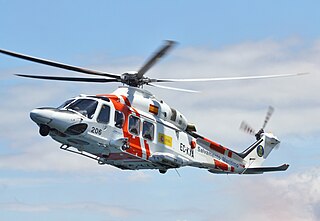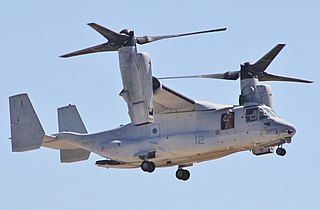
A tiltrotor is an aircraft that generates lift and propulsion by way of one or more powered rotors mounted on rotating shafts or nacelles usually at the ends of a fixed wing. Almost all tiltrotors use a transverse rotor design, with a few exceptions that use other multirotor layouts.

Bell Textron Inc. is an American aerospace manufacturer headquartered in Fort Worth, Texas. A subsidiary of Textron, Bell manufactures military rotorcraft at facilities in Fort Worth, and Amarillo, Texas, USA as well as commercial helicopters in Mirabel, Quebec, Canada.

The Rolls-Royce Turbomeca RTM322 is a turboshaft engine produced by Safran Helicopter Engines. It was originally conceived and manufactured by Rolls-Royce Turbomeca Limited, a joint venture between Rolls-Royce plc and Turbomeca. The engine was designed to suit a wide range of military and commercial helicopter designs. The RTM322 can also be employed in maritime and industrial applications.

The AgustaWestlandAW609, formerly the Bell/Agusta BA609, is a twin-engined tiltrotor VTOL aircraft with a configuration similar to that of the Bell Boeing V-22 Osprey. It is capable of landing vertically like a helicopter while having a range and speed in excess of conventional rotorcraft. The AW609 is aimed at the civil aviation market, in particular VIP customers and offshore oil and gas operators.

The PZL SW-4 Puszczyk is a Polish light single-engine multipurpose helicopter manufactured by PZL-Świdnik. Following a protracted development, the SW-4 entered service in 2002, the primary operator of the type has been the Polish Armed Forces. The SW-4 was further developed by PZL-Świdnik and corporate parent AgustaWestland into an optionally piloted vehicle, the SW-4 Solo. From 2016 onwards, the type has been marketed to civil operators as the AW009, while the SW-4 designation is used for the military market.
A convertiplane is defined by the Fédération Aéronautique Internationale as an aircraft which uses rotor power for vertical takeoff and landing (VTOL) and converts to fixed-wing lift in normal flight. In the US it is further classified as a sub-type of powered lift. In popular usage it sometimes includes any aircraft that converts in flight to change its method of obtaining lift.

The AgustaWestland AW139, now known as the Leonardo AW139, is a 15-seat medium-sized twin-engined helicopter developed and produced by the Anglo-Italian helicopter manufacturer AgustaWestland, now part of Leonardo. It is marketed at several different roles, including VIP/corporate transport, military use, offshore transport, firefighting, law enforcement, search and rescue, emergency medical service, disaster relief, and maritime patrol.

The General Electric T700 and CT7 are a family of turboshaft and turboprop engines in the 1,500–3,000 shp (1,100–2,200 kW) class.

A powered lift aircraft takes off and lands vertically under engine power but uses a fixed wing for horizontal flight. Like helicopters, these aircraft do not need a long runway to take off and land, but they have a speed and performance similar to standard fixed-wing aircraft in combat or other situations.

The AgustaWestland AW119 Koala, produced by Leonardo since 2016, is an eight-seat utility helicopter powered by a single turboshaft engine produced for the civil market. Introduced as the Agusta A119 Koala prior to the Agusta-Westland merger, it is targeted at operators favoring lower running costs of a single-engine aircraft over the redundancy of a twin.

A proprotor is a spinning airfoil that function as both an airplane-style propeller and a helicopter-style rotor. Several proprotor-equipped convertiplanes, such as the Bell Boeing V-22 Osprey tiltrotor, are capable of switching back and forth between flying akin to both helicopters and fixed-wing aircraft. Accordingly this type of airfoil has been predominantly applied to vertical takeoff and landing (VTOL) aircraft.

The AgustaWestland AW189 is a twin-engined, super-medium-lift helicopter manufactured by Leonardo S.p.A. It is derived from the AW149, and shares similarities with the AW139 and AW169.

The AgustaWestland AW169 is a twin-engine, 10-seat, 4.8t helicopter developed and manufactured by the helicopter division of Leonardo. It was designed to share similarities with the larger AgustaWestland AW139 and AgustaWestland AW189.

The Clean Sky Joint Undertaking (CSJU) is a public-private partnership between the European Commission and the European aeronautics industry that coordinates and funds research activities to deliver significantly quieter and more environmentally friendly aircraft. The CSJU manages the Clean Sky Programme (CS) and the Clean Sky 2 Programme (CS2), making it Europe's foremost aeronautical research body.

The Bell V-280 Valor is a tiltrotor aircraft being developed by Bell Helicopter for the United States Army's Future Vertical Lift (FVL) program. The aircraft was officially unveiled at the 2013 Army Aviation Association of America's (AAAA) Annual Professional Forum and Exposition in Fort Worth, Texas. The V-280 made its first flight on 18 December 2017 in Amarillo, Texas.

The AgustaWestland Project Zero is a hybrid tiltrotor/Lift fan aircraft. It has been developed by AgustaWestland as a technology demonstrator, and is used to investigate all-electric propulsion and other advanced technologies. It is the world's first electric tiltrotor aircraft.

The Vertical Take-Off and Landing Experimental Aircraft program is an American research project sponsored by the Defense Advanced Research Projects Agency (DARPA). The goal of the program is to demonstrate a VTOL aircraft design that can take off vertically and efficiently hover, while flying faster than conventional rotorcraft. There have been many previous attempts, most of them unsuccessful.

The Airbus Helicopters H160 is a medium utility helicopter developed by Airbus Helicopters. Formally launched at Heli-Expo in Orlando, Florida on 3 March 2015, it is intended to replace the AS365 and EC155 models in the firm's lineup. In June 2015, the first test flight took place. It received its EASA type certification in July 2020, and first deliveries were in December 2021.
European Future Advanced Rotorcraft (EuroFAR) was a proposed tiltrotor aircraft that was pursued during the 1980s and 1990s. It was a collaborative programme undertaken by the EuroFAR consortium, which comprised Aerospatiale, Agusta, Aeritalia, Messerschmitt-Bölkow-Blohm, Westland, and Construcciones Aeronáuticas SA (CASA).

















